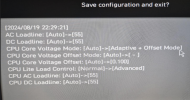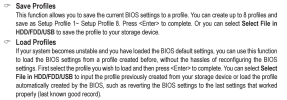Install the app
How to install the app on iOS
Follow along with the video below to see how to install our site as a web app on your home screen.
Note: This feature may not be available in some browsers.
You are using an out of date browser. It may not display this or other websites correctly.
You should upgrade or use an alternative browser.
You should upgrade or use an alternative browser.
Intel Raptor Lake voltage problem
- Thread starter homerdog
- Start date
-
- Tags
- intel raptor lake voltage
Yea but it's dumping 200W into a Deepcool AK400. If this cooler isn't enough then I'll tune the CPU down to work with it.That temp seems pretty high for a 13600k no?
Besides it only uses power like that when I'm running a stress test or if shaders are compiling. Normal temps while gaming are around 65C.
Yea but it's dumping 200W into a Deepcool AK400. If this cooler isn't enough then I'll tune the CPU down to work with it.
Besides it only uses power like that when I'm running a stress test or if shaders are compiling. Normal temps while gaming are around 65C.
Yah, that makes sense. Didn't realize a 13600k used quite that much, but they can that gen definitely can draw a lot more power in synthetic benchmarks that in gaming.
I didn't realize that either before I bought it. I looked at the specs from Intel and assumed that was accurate when deciding on cooling. The power limit I see in HWMonitor is 4096WYah, that makes sense. Didn't realize a 13600k used quite that much, but they can that gen definitely can draw a lot more power in synthetic benchmarks that in gaming.
I think it tries to hit 5.1GHz (max turbo) on the P cores and 3.9GHz (max turbo) on the E cores and throttles from temperature. There is no power limit. With all the cores at their max turbo limit under full load my 13600K draws about 200W. This is the default behavior on my mobo, at least it is with XMP enabled. No wonder there's problems lol.
Last edited:
Have you noticed any changes positive or negative since the update?thanks, MSI. you release a beta bios with 129 microcode and then you release a non-beta bios with the 129 the day after and now i have to update again grumble grumble
no it seems fine? i havent hooked an oscilloscope up to anything so i have to trust that there are no transient voltage spikes that will harm my cpuHave you noticed any changes positive or negative since the update?
i have lifted the limits i put on earlier and i am back to stock multipliers and running default intel settings but i did set the (apparently msi only) CPU lite load mode to 7 (or was it 8?) down from 12 just to do a bit of an undervolt
yeah so my understanding of the MSI setting CPU lite load was not correct. its a way to set the AC and DC load lines
but it seems this is not the best way to undervolt if you want CEP (current excursion prevention) enabled
i can recommend videos by buildzoid who goes into this, albeit in a rambling unedited form but it is informative though sometimes you may want to play it at 2x speed)
oh and btw doesnt he sound like Kermit the frog?

 www.youtube.com
www.youtube.com
but it seems this is not the best way to undervolt if you want CEP (current excursion prevention) enabled
i can recommend videos by buildzoid who goes into this, albeit in a rambling unedited form but it is informative though sometimes you may want to play it at 2x speed)
oh and btw doesnt he sound like Kermit the frog?
Actually Hardcore Overclocking
Teile deine Videos mit Freunden, Verwandten oder der ganzen Welt
so this is my new settings instead of using the CPU lite load stuff because i want to have CEP enabled (because its part of the Intel default settings) I have set this based on this video
fingers crossed im going to run some heavy stuff to see if this is stable (prime95, cinebench r23, r24 and maybe something else i dont know)
edit: ok cinebench r23 crashed so im going to try -0.090 edit 2: blechhhhh i give up

edit 3: im not smart enough or patient for this right now, so i went back to cpu lite load mode 9 and everything else auto and intel default. i just have to trust msi and intel
fingers crossed im going to run some heavy stuff to see if this is stable (prime95, cinebench r23, r24 and maybe something else i dont know)
edit: ok cinebench r23 crashed so im going to try -0.090 edit 2: blechhhhh i give up

edit 3: im not smart enough or patient for this right now, so i went back to cpu lite load mode 9 and everything else auto and intel default. i just have to trust msi and intel
Last edited:
I've been watching his videos and I did notice that he sounds like Kermit. He knows what he's doing but his videos are 60+ minutes of him figuring stuff out in realtime and TBH even at 2x speed it's too much for me. He might change his mind about something at the 30 minute mark which I respect, but this style would be more suited to a livestream. To be fair he does title some of his videos things like "rambling about..." etc.yeah so my understanding of the MSI setting CPU lite load was not correct. its a way to set the AC and DC load lines
but it seems this is not the best way to undervolt if you want CEP (current excursion prevention) enabled
i can recommend videos by buildzoid who goes into this, albeit in a rambling unedited form but it is informative though sometimes you may want to play it at 2x speed)
oh and btw doesnt he sound like Kermit the frog?

Actually Hardcore Overclocking
Teile deine Videos mit Freunden, Verwandten oder der ganzen Weltwww.youtube.com
CapFrameX person/people made this tool for stressing cores. Have not tried it yet, but could be useful. Stresses a core at a time using avx2. Not sure if it can do two at a time.

 github.com
github.com
GitHub - CXWorld/CoreRipperX: Small stress test using AVX2 operations
Small stress test using AVX2 operations. Contribute to CXWorld/CoreRipperX development by creating an account on GitHub.
I finally updated to the new BIOS. With all the exact same settings temps and power use have gone up measurably, causing performance to drop a bit and noise to go up. Before the CPU wouldn't pass ~81C running Cinebench R23. Now it gets to the mid-high 80s and the frequency drops from 5.1 to 5GHz. Why would limiting voltage cause power/temps to go up?so this is my new settings instead of using the CPU lite load stuff because i want to have CEP enabled (because its part of the Intel default settings) I have set this based on this video
fingers crossed im going to run some heavy stuff to see if this is stable (prime95, cinebench r23, r24 and maybe something else i dont know)
edit: ok cinebench r23 crashed so im going to try -0.090 edit 2: blechhhhh i give up
View attachment 11894
edit 3: im not smart enough or patient for this right now, so i went back to cpu lite load mode 9 and everything else auto and intel default. i just have to trust msi and intel
I even went with a more aggressive undervolt on the new BIOS and temps won't really go down.
OK lowering the Ring voltage makes power/temps go down. I had it at -0.050V offset on the old BIOS. On the new one going to -0.065V is getting me closer to my previous results.
How low should I be able to go on the ring voltage offset?
For now I'm settling on -0.075V on the ring and -0.095V on the core. This limits the performance loss from the new BIOS to about 3%. R23 score went from avg. 24137 to 23559.
Last edited:
You can go as low as the CPU stability allows, of course  Crank it down a notch or two, test thoroughly, repeat until tests fail, and then crank it back up one or two notches.
Crank it down a notch or two, test thoroughly, repeat until tests fail, and then crank it back up one or two notches.
IIRC part of these microcode issues resulted in misreporting CPU temperatures by as much as six degrees celcius, explaining why you now see it "running hotter." It is likely to have always been running at those temps, and was misreporting it the whole time. This misreporting of temperatures was also part of the core reason for the degredation, as the firmware would calculate Intel's Thermal Velocity Boost incorrectly (eg thinking it's running cooler than it is) which would permit a longer (unsafe) duration of higher power and related voltage.
IIRC part of these microcode issues resulted in misreporting CPU temperatures by as much as six degrees celcius, explaining why you now see it "running hotter." It is likely to have always been running at those temps, and was misreporting it the whole time. This misreporting of temperatures was also part of the core reason for the degredation, as the firmware would calculate Intel's Thermal Velocity Boost incorrectly (eg thinking it's running cooler than it is) which would permit a longer (unsafe) duration of higher power and related voltage.
I see. Well I just disabled the "Intel Default" setting in the BIOS that I hadn't noticed until now. This caused temps to go down by about 5C and now the CPU sits at 5.1GHz during the full R23 run.You can go as low as the CPU stability allows, of courseCrank it down a notch or two, test thoroughly, repeat until tests fail, and then crank it back up one or two notches.
IIRC part of these microcode issues resulted in misreporting CPU temperatures by as much as six degrees celcius, explaining why you now see it "running hotter." It is likely to have always been running at those temps, and was misreporting it the whole time. This misreporting of temperatures was also part of the core reason for the degredation, as the firmware would calculate Intel's Thermal Velocity Boost incorrectly (eg thinking it's running cooler than it is) which would permit a longer (unsafe) duration of higher power and related voltage.
Fortunately I took a picture of the settings before updating. The Intel Default option wasn't there before. It's now on by default. Turning that off causes it to run cooler, quieter, and faster
Nevermind about the score not changing. I had TeamViewer running in the background. Quitting that (it was off in the before testing) got the score back up to margin of error with the before settings.
In summation the Intel Default setting uses more power and is slower. With that off the computer is now quieter than it was before the update, probably because I'm keeping the lower voltages.
Also in HWMonitor with Intel default, PL1/PL2 is 181W. With Intel Default off it's 4095W. And yet it uses less power (~140W vs 160W) in R23 with Intel Default turned off.
Last edited:
most boards allow you to save setting (though not sure if they survive a bios flash)I don't want to update the BIOS and have to re-apply all my settings and have them drop a new update on me right after that.
It doesn't survive.most boards allow you to save setting (though not sure if they survive a bios flash)
I went back to Ring -0.05V and vcore -0.075V because of BSODs in Prime95. So it's all back to normal now, basically the same as it was before the update. I think all I had to do was update it, put my settings back, and disable the new Intel Default setting.
Last edited:
digitalwanderer
Legend
After any bios/UEFI flashes you should always do the "reset to default settings". A lot of times the flashing can change current features and add new ones, resetting to default can save you some heart aches of oddities happening because your old settings don't mesh with the newly flashed bios settings.most boards allow you to save setting (though not sure if they survive a bios flash)
It's more trouble but well worth it in the long run. If you're gonna do it then do it right.
Similar threads
- Replies
- 7
- Views
- 2K
- Replies
- 1
- Views
- 8K
- Replies
- 126
- Views
- 50K
- Replies
- 98
- Views
- 36K

